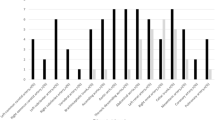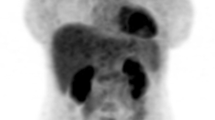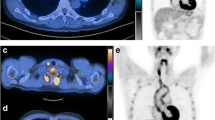Abstract
Purpose
To explore the feasibility and clinical value of 5-h delayed 18F-fluorodeoxyglucose (18F-FDG) total-body (TB) positron emission tomography/computed tomography (PET/CT) in patients with Takayasu arteritis (TA).
Methods
This study included nine healthy volunteers who underwent 1-, 2.5-, and 5-h triple-time TB PET/CT scans and 55 patients with TA who underwent 2- and 5-h dual-time TB PET/CT scans with 1.85 MBq/kg 18F-FDG. The liver, blood pool, and gluteus maximus muscle signal-to-noise ratios (SNRs) were calculated by dividing the SUVmean by its standard deviation to evaluate imaging quality. TA lesions’ 18F-FDG uptake was graded on a three-point scale (I, II, III), with grades II and III considered positive lesions. Lesion-to-blood maximum standardised uptake value (SUVmax) ratio (LBR) was calculated by dividing the lesion SUVmax by the blood pool SUVmax.
Results
The liver, blood pool, and muscle SNR of the healthy volunteers at 2.5- and 5-h were similar (0.117 and 0.115, respectively, p = 0.095). We detected 415 TA lesions in 39 patients with active TA. The average 2- and 5-h scan LBRs were 3.67 and 7.59, respectively (p < 0.001). Similar TA lesion detection rates were noted in the 2-h (92.0%; 382/415) and 5-h (94.2%; 391/415) scans (p = 0.140). We detected 143 TA lesions in 19 patients with inactive TA. The 2- and 5-h scan LBRs were 2.99 and 5.71, respectively (p < 0.001). Similar positive detection rates in inactive TA were noted in the 2-h (97.9%; 140/143) and 5-h (98.6%; 141/143) scans (p = 0.500).
Conclusion
The 2- and 5-h 18F-FDG TB PET/CT scans had similar positive detection rates, but both combined could better detect inflammatory lesions in patients with TA.





Similar content being viewed by others
Data availability
The datasets generated during and/or analyzed during the current study are available from the corresponding author on reasonable request.
Abbreviations
- 18F-FDG:
-
18F-fluorodeoxyglucose
- AFOV:
-
Axial field-of-view
- ESR:
-
Erythrocyte sedimentation rate
- LLR:
-
Lesion-to-liver maximum standardized uptake value ratio
- LBR:
-
Lesion-to-blood maximum standardized uptake value ratio
- MR:
-
Magnetic resonance
- PET/CT:
-
Positron emission tomography/computed tomography
- ROI:
-
Region of interest
- SNR:
-
Signal-to-noise ratio
- SUVblood :
-
Blood maximum standard uptake value
- SUVliver :
-
Liver maximum standard uptake value
- SUVmax :
-
Maximum standard uptake value
- SUVmean :
-
Mean standard uptake value
- TA:
-
Takayasu arteritis
- TB:
-
Total-body
References
Cherry SR, Jones T, Karp JS, Qi J, Moses WW, Badawi RD. Total-body PET: maximizing sensitivity to create new opportunities for clinical research and patient care. J Nucl Med. 2018;59:3–12. https://doi.org/10.2967/jnumed.116.184028.
Zhang YQ, Hu PC, Wu RZ, Gu YS, Chen SG, Yu HJ, et al. The image quality, lesion detectability, and acquisition time of (18)F-FDG total-body PET/CT in oncological patients. Eur J Nucl Med Mol Imaging. 2020;47:2507–15. https://doi.org/10.1007/s00259-020-04823-w.
Liu G, Hu P, Yu H, Tan H, Zhang Y, Yin H, et al. Ultra-low-activity total-body dynamic PET imaging allows equal performance to full-activity PET imaging for investigating kinetic metrics of (18)F-FDG in healthy volunteers. Eur J Nucl Med Mol Imaging. 2021. https://doi.org/10.1007/s00259-020-05173-3.
Tan H, Cai D, Sui X, Qi C, Mao W, Zhang Y, et al. Investigating ultra-low-dose total-body [18F]-FDG PET/CT in colorectal cancer: initial experience. Eur J Nucl Med Mol Imaging. 2022;49:1002–11. https://doi.org/10.1007/s00259-021-05537-3.
Badawi RD, Shi H, Hu P, Chen S, Xu T, Price PM, et al. First human imaging studies with the EXPLORER total-body PET scanner. J Nucl Med. 2019;60:299–303. https://doi.org/10.2967/jnumed.119.226498.
Ozutemiz C, Neil EC, Tanwar M, Rubin NT, Ozturk K, Cayci Z. The role of dual-phase FDG PET/CT in the diagnosis and follow-up of brain tumors. AJR Am J Roentgenol. 2020;215:985–96. https://doi.org/10.2214/AJR.19.22571.
Parghane RV, Basu S. Dual-time point (18)F-FDG-PET and PET/CT for differentiating benign from malignant musculoskeletal lesions: opportunities and limitations. Semin Nucl Med. 2017;47:373–91. https://doi.org/10.1053/j.semnuclmed.2017.02.009.
Mason JC. Takayasu arteritis–advances in diagnosis and management. Nat Rev Rheumatol. 2010;6:406–15. https://doi.org/10.1038/nrrheum.2010.82.
Kerr GS, Hallahan CW, Giordano J, Leavitt RY, Fauci AS, Rottem M, et al. Takayasu arteritis. Ann Intern Med. 1994;120:919–29. https://doi.org/10.7326/0003-4819-120-11-199406010-00004.
Wen D, Du X, Ma CS. Takayasu arteritis: diagnosis, treatment and prognosis. Int Rev Immunol. 2012;31:462–73. https://doi.org/10.3109/08830185.2012.740105.
Mavrogeni S, Dimitroulas T, Chatziioannou SN, Kitas G. The role of multimodality imaging in the evaluation of Takayasu arteritis. Semin Arthritis Rheum. 2013;42:401–12. https://doi.org/10.1016/j.semarthrit.2012.07.005.
Tezuka D, Haraguchi G, Ishihara T, Ohigashi H, Inagaki H, Suzuki J, et al. Role of FDG PET-CT in Takayasu arteritis: sensitive detection of recurrences. JACC Cardiovasc Imaging. 2012;5:422–9. https://doi.org/10.1016/j.jcmg.2012.01.013.
Santhosh S, Mittal BR, Gayana S, Bhattacharya A, Sharma A, Jain S. F-18 FDG PET/CT in the evaluation of Takayasu arteritis: an experience from the tropics. J Nucl Cardiol. 2014;21:993–1000. https://doi.org/10.1007/s12350-014-9910-8.
Kwon OC, Jeon TJ, Park MC. Vascular uptake on (18)F-FDG PET/CT during the clinically inactive state of takayasu arteritis is associated with a higher risk of relapse. Yonsei Med J. 2021;62:814–21. https://doi.org/10.3349/ymj.2021.62.9.814.
Hu P, Lin X, Zhuo W, Tan H, Xie T, Liu G, et al. Internal dosimetry in F-18 FDG PET examinations based on long-time-measured organ activities using total-body PET/CT: does it make any difference from a short-time measurement? EJNMMI Phys. 2021;8:51. https://doi.org/10.1186/s40658-021-00395-2.
Boellaard R, Delgado-Bolton R, Oyen WJ, Giammarile F, Tatsch K, Eschner W, et al. FDG PET/CT: EANM procedure guidelines for tumour imaging: version 20. Eur J Nucl Med Mol Imaging. 2015;42:328–54. https://doi.org/10.1007/s00259-014-2961-x.
Sui X, Liu G, Hu P, Chen S, Yu H, Wang Y, et al. Total-Body PET/computed tomography highlights in clinical practice: experiences from Zhongshan Hospital. Fudan University PET Clin. 2021;16:9–14. https://doi.org/10.1016/j.cpet.2020.09.007.
Bucerius J, Hyafil F, Verberne HJ, Slart RH, Lindner O, Sciagra R, et al. Position paper of the Cardiovascular Committee of the European Association of Nuclear Medicine (EANM) on PET imaging of atherosclerosis. Eur J Nucl Med Mol Imaging. 2016;43:780–92. https://doi.org/10.1007/s00259-015-3259-3.
Ma LY, Wu B, Jin XJ, Sun Y, Kong XF, Ji ZF, et al. A novel model to assess disease activity in Takayasu arteritis based on 18F-FDG-PET/CT: a Chinese cohort study. Rheumatology (Oxford). 2022;61:SI14-SI22. https://doi.org/10.1093/rheumatology/keab487.
Grayson PC, Alehashemi S, Bagheri AA, Civelek AC, Cupps TR, Kaplan MJ, et al. (18) F-fluorodeoxyglucose-positron emission tomography as an imaging biomarker in a prospective, longitudinal cohort of patients with large vessel vasculitis. Arthritis Rheumatol. 2018;70:439–49. https://doi.org/10.1002/art.40379.
Arend WP, Michel BA, Bloch DA, Hunder GG, Calabrese LH, Edworthy SM, et al. The American College of Rheumatology 1990 criteria for the classification of Takayasu arteritis. Arthritis Rheum. 1990;33:1129–34. https://doi.org/10.1002/art.1780330811.
Walter MA, Melzer RA, Schindler C, Muller-Brand J, Tyndall A, Nitzsche EU. The value of [18F]FDG-PET in the diagnosis of large-vessel vasculitis and the assessment of activity and extent of disease. Eur J Nucl Med Mol Imaging. 2005;32:674–81. https://doi.org/10.1007/s00259-004-1757-9.
Zhang X, Zhou J, Sun Y, Shi H, Ji Z, Jiang L. (18)F-FDG-PET/CT: an accurate method to assess the activity of Takayasu’s arteritis. Clin Rheumatol. 2018;37:1927–35. https://doi.org/10.1007/s10067-017-3960-7.
Chen S, Hu P, Gu Y, Yu H, Shi H. Performance characteristics of the digital uMI550 PET/CT system according to the NEMA NU2-2018 standard. EJNMMI Physics. 2020;7(1):43. https://doi.org/10.1186/s40658-020-00315-w.
Derlin T, Spencer BA, Mamach M, Abdelhafez Y, Nardo L, Badawi RD, et al. Exploring vessel wall biology in vivo by ultra-sensitive total-body positron emission tomography. J Nucl Med. 2022. https://doi.org/10.2967/jnumed.122.264550. Online ahead of print.
Tan H, Gu Y, Yu H, Hu P, Zhang Y, Mao W, et al. Total-body PET/CT: current applications and future perspectives. AJR Am J Roentgenol. 2020;215:325–37. https://doi.org/10.2214/AJR.19.22705.
Maz M, Chung SA, Abril A, Langford CA, Gorelik M, Guyatt G, et al. 2021 American College of Rheumatology/Vasculitis Foundation Guideline for the Management of Giant Cell Arteritis and Takayasu Arteritis. Arthritis Rheumatol. 2021;73:1349–65. https://doi.org/10.1002/art.41774.
Funding
This work was supported by grants from the Three-year Action Plan of Clinical Skills and Innovation of Shanghai Hospital Development Center (No. SHDC2020CR3079B to H. S.), the Shanghai Municipal Key Clinical Specialty (No. shslczdzk03401 to H. S.), the Science and Technology Committee of Shanghai Municipality (No. 20DZ2201800 to Y.Z.), the Clinical Research Project of Zhongshan Hospital, Fudan University (No. 2020ZSLC63 to Y.Z.), and the Shanghai "Rising Stars of Medical Talent" Youth Development Program (No. SHWRS[2020]_087 to Y.Z.).
Author information
Authors and Affiliations
Contributions
Dilibire Adili, Danjie Cai, Bing Wu, Yushen Gu, Yiqiu Zhang, and Hongcheng Shi were involved designing the study. Dilibire Adili, Danjie Cai, Yiqiu Zhang, and Hongcheng Shi contributed to data analysis and manuscript preparation. Haojun Yu helped with image acquisition and processing. All authors discussed the results and commented on the manuscript. All authors read and approved the final manuscript.
Corresponding authors
Ethics declarations
Ethics approval
This study was performed in line with the principles of the 1964 Declaration of Helsinki and its later amendments. The Ethics Committee of Zhongshan Hospital, Fudan University approved this retrospective study. Written informed consent was obtained from all participants.
Consent to participate
Informed consent was obtained from all individual participants included in the study.
Consent for publication
The authors affirm that human research participants provided informed consent for publication of the images in Figs. 1, 3, 4, and 5.
Competing interests
The authors declare that they have no competing interests.
Additional information
Publisher's note
Springer Nature remains neutral with regard to jurisdictional claims in published maps and institutional affiliations.
This article is part of the Topical Collection on Infection and inflammation.
Rights and permissions
Springer Nature or its licensor (e.g. a society or other partner) holds exclusive rights to this article under a publishing agreement with the author(s) or other rightsholder(s); author self-archiving of the accepted manuscript version of this article is solely governed by the terms of such publishing agreement and applicable law.
About this article
Cite this article
Adili, D., Cai, D., Wu, B. et al. An exploration of the feasibility and clinical value of half-dose 5-h total-body 18F-FDG PET/CT scan in patients with Takayasu arteritis. Eur J Nucl Med Mol Imaging 50, 2375–2385 (2023). https://doi.org/10.1007/s00259-023-06168-6
Received:
Accepted:
Published:
Issue Date:
DOI: https://doi.org/10.1007/s00259-023-06168-6




